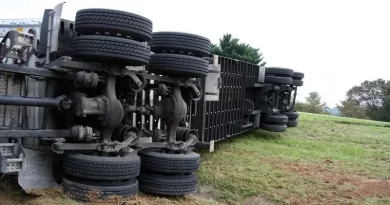Safety Innovations in Trucking: Preventing Accidents and Saving Lives
Safety has always been a paramount concern in the trucking industry. With millions of miles traveled by heavy-duty trucks every year, ensuring the well-being of both drivers and other road users is a top priority. Fortunately, the trucking industry is witnessing a revolution in safety innovations driven by advanced technology and data analytics. These innovations are not only helping to prevent accidents but also saving lives on our highways.
The Current State of Trucking Safety
The current state of trucking safety reveals a pressing need for improvement. Accidents involving large trucks often result in severe consequences, including fatalities and serious injuries. According to data from the National Highway Traffic Safety Administration (NHTSA), in 2020, there were 4,698 fatalities in crashes involving large trucks. While this number has decreased from previous years, it underscores the importance of continued efforts to enhance safety.
Truck drivers face numerous challenges on the road, including long hours, fatigue, and adverse weather conditions. These factors contribute to the risk of accidents. Additionally, commercial trucks’ sheer size and weight mean that accidents involving them tend to have more severe outcomes. Therefore, addressing safety concerns in the industry is crucial to protect truck drivers and all road users.
The Role of Technology in Enhancing Safety
Integrating advanced technology into trucks is one of the most promising developments in the trucking industry’s quest for safety. These technologies are designed to assist drivers, mitigate risks, and reduce accidents. Collision avoidance systems, for instance, use sensors and cameras to detect obstacles and apply brakes automatically if a collision is imminent. Lane departure warning systems alert drivers if they unintentionally drift out of their lane, helping to prevent lane-change accidents.
These innovations have already demonstrated their effectiveness in real-world scenarios. Reports of accidents avoided due to the intervention of such systems have been numerous. Trucking companies are increasingly investing in these technologies to protect their drivers and reduce the financial and reputational costs associated with accidents.
Advancements in Driver Assistance Systems
In addition to collision avoidance and lane departure warning systems, there have been significant advancements in driver assistance systems. Adaptive cruise control, for instance, automatically adjusts a truck’s speed to maintain a safe following distance from the vehicle in front. Automatic emergency braking can apply the brakes if the system detects an impending collision, even if the driver does not react in time. These technologies work hand in hand with drivers, providing an extra layer of safety.
Real-world examples of how these systems have prevented accidents are becoming increasingly common. Truck drivers have recounted instances where automatic emergency braking systems prevented rear-end collisions, and adaptive cruise control systems, maintained a safe distance in heavy traffic, reducing the likelihood of accidents.
Telematics and Data Analytics
Telematics and data analytics are also playing a significant role in improving safety in the trucking industry. Telematics systems collect and transmit data on vehicle performance and driver behavior. This information is then analyzed to identify risky behaviors and provide feedback to drivers and fleet managers. For instance, telematics can monitor sudden acceleration, harsh braking, and speeding, allowing companies to address these behaviors through training and incentives.
Furthermore, telematics systems can track driver hours to ensure compliance with Hours of Service (HOS) regulations, which are designed to reduce driver fatigue and enhance safety. By monitoring HOS electronically, companies can help prevent drivers from exceeding their allowable driving hours, reducing the risk of accidents caused by fatigue.
Training and Education for Truck Drivers
While technology is pivotal in improving safety, the human factor cannot be overlooked. Training and education for truck drivers are essential components of any safety strategy. Drivers need to be aware of the capabilities and limitations of safety technologies and best practices for safe driving.
Trucking companies invest in ongoing safety training and education programs for their drivers. These programs cover various topics, from defensive driving techniques to fatigue management and load securement. In addition to enhancing safety, such training can positively impact driver morale and job satisfaction.
Regulatory Changes and Safety Standards
Government agencies have recognized the importance of safety in the trucking industry and have implemented regulatory changes and safety standards to address concerns. For instance, Hours of Service (HOS) regulations have been revised to limit driving hours and require rest breaks, reducing driver fatigue. Mandatory electronic logging devices (ELDs) are now used to monitor HOS compliance.
Moreover, there is an ongoing focus on improving vehicle safety standards. Advances in vehicle design, including better crash protection features and improved stability control systems, have been mandated to enhance safety. These regulations aim to reduce the likelihood of accidents and their severity when they do occur.
Challenges and Limitations
Despite the promising developments in trucking safety, challenges and limitations exist. Technology, while a valuable tool, is not infallible. Sensors and systems can fail, and drivers must remain vigilant and ready to take control when necessary. Moreover, not all trucks on the road are equipped with the latest safety features, and older vehicles may lack these advancements.
There’s also the challenge of driver distraction, which remains a significant concern. While safety technologies can assist drivers, they should not be seen as a substitute for responsible driving behavior. Ensuring drivers remain focused on the road and attentive to changing conditions is an ongoing challenge.
The Impact on Accidents and Insurance
The impact of safety innovations on reducing accidents and improving overall road safety is substantial. Trucks with advanced safety technologies are less likely to be involved in accidents, resulting in fewer injuries and fatalities. This positive trend has significant implications for the trucking industry’s insurance costs.
Insurance companies recognize the value of safety innovations and may offer reduced premiums to trucking companies that invest in these technologies. Safer driving records, lower accident rates, and reduced severity of accidents can lead to substantial cost savings for trucking companies, making safety investments a matter of ethics and an intelligent business decision.
The Human Factor in Safety
While technology has brought about remarkable improvements in trucking safety, it’s important to emphasize that the human factor remains central. Truck drivers are the ultimate decision-makers on the road. No technology can replace a skilled driver’s judgment, experience, and vigilance.
Technology should be viewed as a complement to, rather than a replacement for, responsible driving. Drivers must undergo proper training, understand the capabilities and limitations of safety systems, and remain engaged and attentive while behind the wheel. Combining skilled drivers and advanced safety technologies is the most effective formula for reducing accidents and saving lives.
Looking Ahead: Future Trends in Trucking Safety
As technology continues to advance, the future of safety in the trucking industry holds great promise. Emerging technologies such as platooning, where trucks communicate and travel closely together to reduce wind resistance and improve fuel efficiency, have the potential to enhance safety through improved vehicle coordination.
Furthermore, artificial intelligence (AI) and machine learning algorithms will continue to refine safety systems, making them more responsive and adaptive to real-time road conditions. Predictive analytics may also anticipate potential safety hazards and proactively mitigate risks.
In conclusion, safety innovations transform the trucking industry, prevent accidents, and save lives. Advanced technologies such as collision avoidance systems and telematics, combined with ongoing driver training and regulatory changes, are making our highways safer for everyone. While challenges and limitations exist, the future of trucking safety looks bright as technology continues to evolve and enhance our ability to protect truck drivers and the general public. By prioritizing safety, the trucking industry can achieve improved road safety and financial benefits through reduced accidents and insurance costs. It is a win-win scenario where innovation and responsibility go hand in hand.




